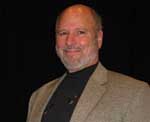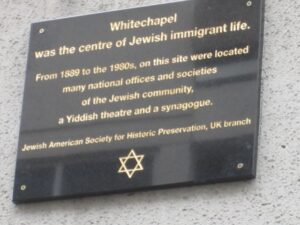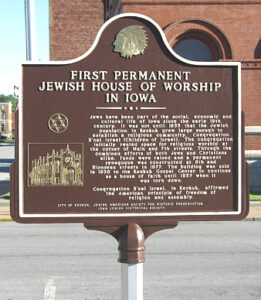By Jerry Klinger

Recently, the Jewish American Society for Historic Preservation’s U.K. branch placed a new historical, interpretive marker in Whitechapel, London. The marker was placed on a building that replaced the Adler House. The Adler House was named in honor of the Chief Rabbi of the British Empire, Hermann Adler, 1891-1911.
The text of the marker reads:
“Whitechapel was the centre of Jewish immigrant life. From 1889-1980s, on this site were located many national offices and societies of the Jewish community, a Yiddish theatre and a synagogue.”
There is a story about the marker that is no longer visible. Gone are the teeming streets of Whitechapel and adjacent Spitalfields filled with pushcarts, the sounds of Yiddish, and the smells of delicatessens. Gone are the yeshivahs, the Steibels, small community synagogues, and the pushings of Jewish humanity huddled in horrifically overcrowded Jewish tenements.
 Much of the area has been rebuilt, having suffered from terrible German bombing during WWII, and the decay of time. Modern buildings graced by sterile concrete gray streets dominate today.
Much of the area has been rebuilt, having suffered from terrible German bombing during WWII, and the decay of time. Modern buildings graced by sterile concrete gray streets dominate today.
There is a story behind the marker. The story is the why of the marker.
In the 1880s, horrific, continuing antisemitic pogroms (riots) and severe economic discrimination forced thousands of Jews to flee Russia and Eastern Europe. Over 100,000 of the desperate refugees settled in London’s East End, the Whitechapel district. By 1900 Whitechapel and Spitalfields were the heart of Jewish London. Following World War II, and the broader British acceptance and integration of Jews into British society, the Jewish community migrated to better parts of London. Whitechapel, as the Jewish community center, largely declined by 1980.
A number of years ago, JASHP placed a vertical historical interpretive highway-style marker, for Congregation B’Nai Israel, in Keokuk, Iowa. B’Nai Israel was the first permanent Jewish house of worship in Iowa, dating to the mid-19th century.
There no longer are Jews living in Keokuk. The city’s once bustling economic community declined in the late 19th century. The Jews moved to Des Moines and other Iowa emerging opportunities.

The memory of Jewish Keokuk, and their many contributions to the community, now are only visible in the stark silent stones, row upon row, in the rarely visited Jewish section of the municipal cemetery.
Generally, after a marker dedication, I go back to look at the marker in the morning, in the quiet time to see if others are observing it.
I stood near the Keokuk marker looking at it when a young mother, complete with baby balancing on her ample hip, walked up and read the marker.
She looked a bit perplexed when she turned to me with a comment.
“I did not know there were Jews here,” she said.
“Yes, there were,” I responded.
The marker was doing its job.
The same with the marker in Whitechapel. It is a simple marker with a job of memory to be told now that most Jews are no longer there.
Establishment British Jewry did not want the great, almost unmanageable masses of Jews flooding into Britain. They feared their strange lantzman, erstwhile brethren, with their foreign customs, language, and approach to God, would rekindle antisemitism. Establishment Jewry had worked very hard to gain admittance, even reluctant admittance, to British life and society if they assimilated.
Like in the U.S., especially New York and its Lower East Side, deluged with the hordes of refugee Jews, establishment Jewry said they feared for the refugee’s safety and wellbeing. Their poverty was monstrous, and the future bleak as Jews continued to stream in.
At least, that is what they said for public consumption.
There was a darker side, though paralleled in the U.K. by Rabbi Nathan Adler, Hermann’s father. Nathan was the chief rabbi of the United Synagogue in Britain. Adler issued a plea in 1888 to Eastern Europe’s desperate Jewry – don’t come.
“….it is difficult for Jewish Immigrants to support themselves and their households, and at times they contravene the will of their Maker on account of poverty and overwork and violate the Sabbath and Festivals. Some have been ensnared in the net of the missionaries and renounced their religion, may the Merciful save. There are many who believe that all the cobblestones of London are precious stones, and that it is a place of gold. Woe and alas, it is not so… I implore every rabbi of a community kindly to preach in the synagogue and house of study, to publicise the evil which is befalling our brethren who have come here, and to warn them not to come to the land of Britain, for such ascent is a descent.”
In the U.S., elements of the establishment German Jewry organized to redirect the Jewish refugees away from New York and the major cities of the East. They deeply feared the possibility of antisemitism. Nativism was a very real phenomenon. The stench of the American Civil War still hung in the air.
German American Jewry’s solution was different because America had a vast underpopulated interior. Ship them to the West. The Galveston plan was put into action. Take the Eastern European Jews and turn them into Cowboys far from the eyes of the East.
The Galveston Plan moved thousands of Jews. Basically, it failed. The Jews remained in the East and tenements of the Lower East Side. Their children melded into America for its vast enrichment.
Jews who settled in Whitechapel/Spitalfields integrated into British life, benefiting and enriching England for all the generations that followed. They never sought a handout, only an opportunity.
Thousands and thousands of Jews became doctors, lawyers, teachers, social workers, politicians, business creators, artists, entertainers, and athletes. Thousands served with meritorious courage, heroes of Britain during the Wars. Many gave their lives for Britain. JASHP is actively placing markers in their commemorations.
A few names from the many who came from Whitechapel/Spitalfields.
Jack Kid Berg, boxer, “The Whitechapel Windmill,” British Lightweight Champion
Stanley Black, bandleader
Georgia Brown (born Lillian Klot), actress and singer,
Peter Cheyney, mystery writer, and journalist
Jack Cohen, founder of the Tesco supermarket chain
Jack “Spot” Comer, Jewish gangster and anti-Fascist,
Bud Flanagan (born Chaim Reuven Weintrop), entertainer.
Isaac Rosenberg, poet, painter,
Barney Barnato, diamond mining industrialist
Marcus Samuel, Lord Mayor of London, Founder of Shell Oil.
Sir Basil Lucas Quixano Henriques philanthropists
Sir Rufus Isaacs, Leader of the House of Lords, Chief Viceroy of India, Chief Justice, and Foreign Secretary of the U.K.
Sir Arnold Wesker, dramatist
Lily Montagu – Social worker and religious leader
Although born in Whitechapel/Spitalfields, some Jews moved to the States and made their mark.
A few names:
Samuel Gompers – American Labor leader,
Abe Saperstein – Founder of the Harlem Globe Trotters
Abraham Beame – first Jewish mayor of New York.
The simple, black, and gold-lettered marker in Whitechapel says far more than its 31 words.
*
Jerry Klinger is the President of the Jewish American Society for Historic Preservation, www.JASHP.org
Just pointing out a typo.. It was Jack ‘Kid’ Berg not Bert.
https://en.m.wikipedia.org/wiki/Jack_Kid_Berg
Fixed! Thanks!